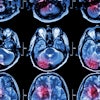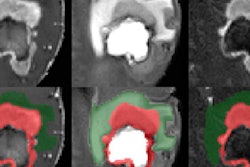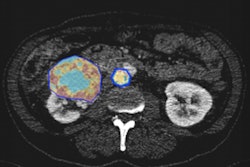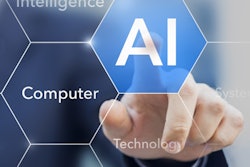
Far from making the radiologist obsolete, artificial intelligence (AI) promises to create more imaging opportunities and boost demand for specialists, delegates heard at last week's joint congress of the International Society of Magnetic Resonance in Medicine and European Society of MR in Medicine and Biology in Paris. But it may be over a decade before AI is making multimodality, multiparametric, or complex MRI diagnoses, they were told.
Dr. Konstantin Nikolaou, chairman and professor in the Department of Diagnostic and Interventional Radiology, University Hospital Tübingen, in Germany, revealed his optimistic response to the question on everybody's lips: "Will AI and machine learning (ML) put my job at risk?" He outlined how technology can boost efficiency and improve workflow.
 Invest in yourself and embrace AI, Dr. Konstantin Nikolaou urges.
Invest in yourself and embrace AI, Dr. Konstantin Nikolaou urges."This is not the last chapter of radiology, just the next chapter -- a question of man and machine, rather than man versus machine," he told AuntMinnieEurope.com. "AI certainly will change the way we work and this is true for all medical specialties, including oncology therapists and anesthetists, for example, not just radiologists."
A symbiotic relationship between radiologists and machines will make diagnoses and patient management far more efficient, Nikolaou predicted. He pointed to how at larger hospitals, on-call radiology residents sometimes needed to plough through over 100 thorax x-rays in a single weekend. Many were second or follow-up exams and showed no change. For these cases, help from machines to read the scans will be a welcome adjunct, he noted.
Just as software can recognize faces, efficiency will be gained from teaching algorithms to recognize certain pathologies, such as suspicious microcalcifications in a mammogram, or abnormalities in a full-body spiral CT for trauma, when looking for vertebral fractures.
"Today, for every screening mammography, a board-certified radiologist other than the primary reader will have to do a second read on all mammograms," Nikolaou said. "Why not potentially use a 'well-trained' ML algorithm as a support for this second reading, to relieve workload?"
For simple questions with "yes/no" answers, such as, "Is there presence of a pneumothorax in the chest x-ray or not?" or, "Is there a suspicious microcalcification in the breast or not?" AI may be able to help in the near future, and thus may be beneficial to workflow, freeing up human experts for more complex tasks, he explained.
For more complex cases, however, the issue of AI making reliable diagnoses seems less pressing for the moment. Nobody is sure just how far away AI is from making multimodality, multiparametric, or complex MRI diagnoses, but Nikolaou estimates at least 10 years. For example, an algorithm that is trained to detect or even grade prostate cancer from a multiparametric MRI can't differentiate between a significantly higher grade prostate cancer and an inflammation, as it is not trained to do so and does not know about the differential diagnosis of tumor versus inflammation.
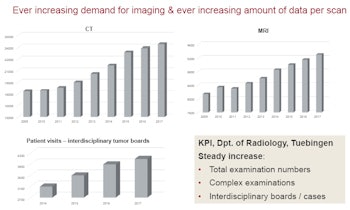
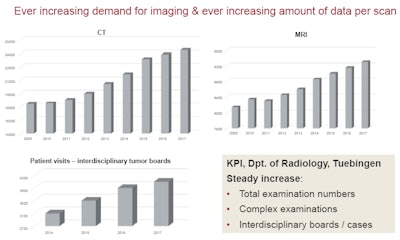
Demand for imaging has risen consistently over the past decade at Tübingen, as has the amount of data per scan. Figure courtesy of Dr. Konstantin Nikolaou.
AI in complex imaging and diagnoses may also be coming, but not that soon, he noted. Even in the longer term, Nikolaou reassured radiologists that nobody will lose their jobs.
"If we can develop ML to recognize more complex texture features, imaging will become even more central to patient diagnosis. Its value, and consequently demand, will increase and radiologists will be needed even more," he said. "But if we want to change the future, we have to do it ourselves. Invest in yourself and embrace this technology."
Training focus
The trend has already started, as institutions and national and international societies build their own ML academies to integrate AI into medical training. The RSNA recently announced its own AI training courses, while the German radiological society, the DRG, has also established its own AI academy and set up a radiomics and AI working group. Nikolaou further pointed to how at Tübingen, the residency program is changing to incorporate more informatics.
The institute is also implementing image quality assessment measures in what he terms a "data preparation" phase, and is concentrating on data quality enhancement, report structuring, and protocol standardization to ensure that optimized data will feed the algorithms.
Besides medical expertise, programming, or coding skills, mathematics and statistics are key to harnessing the new "big data" required for effective AI implementation, namely the training of ML systems for use in clinical practice, he said.
The challenge is understanding what quality and amount of data is required to answer a medical question or problem. If the medical problem is well-defined by the medical expert, complex mathematical, statistical, and programming skills are needed, not just to train the algorithms to handle single medical questions or tasks, but also to make them transferable to other medical questions, he added.
There are many challenges to AI implementation but one mammoth hurdle is the integration of imaging data into other (meta-)data such as histopathological and genetic data. This will allow researchers to prospectively build and combine multidimensional and multiscale datasets that can be mined for complex questions such as predicting response to tumor therapy, for example, and ultimately will support the specialist's decision-making. Such prospective definition and combination of data quality increasingly will make AI algorithms trainable, according to Nikolaou.
"Patient outcomes are not in imaging data by itself. We will need to prove that the new combinations of information from the ML algorithms are feasible in routine practice and improve outcomes for patients," he noted.
While routine AI detection of pneumonia in a chest x-ray may be an imminent reality, AI prediction of tumor treatment response based on complex imaging and on a combination of multidisciplinary meta-data is years away, and dependent on big data, well-defined data quality, and advanced training of ML systems in what will prove to be a complex and multistep process.


